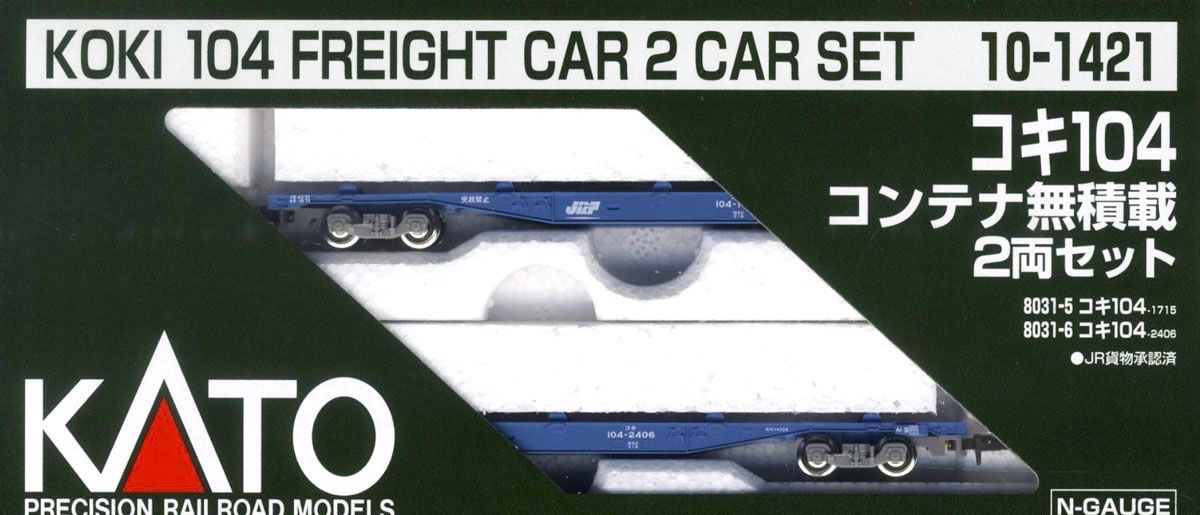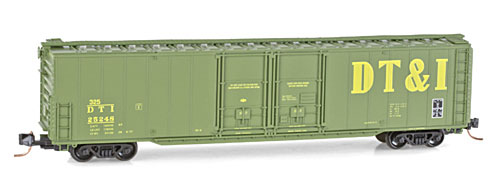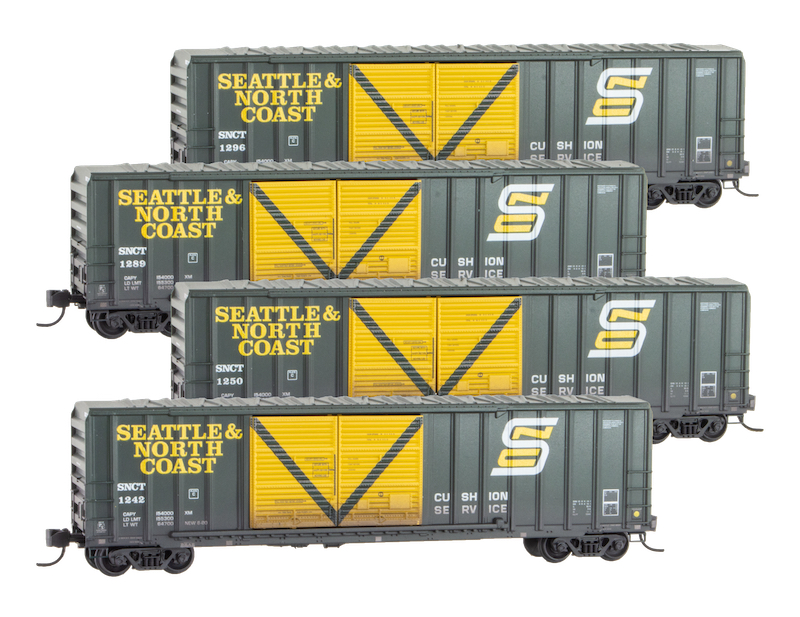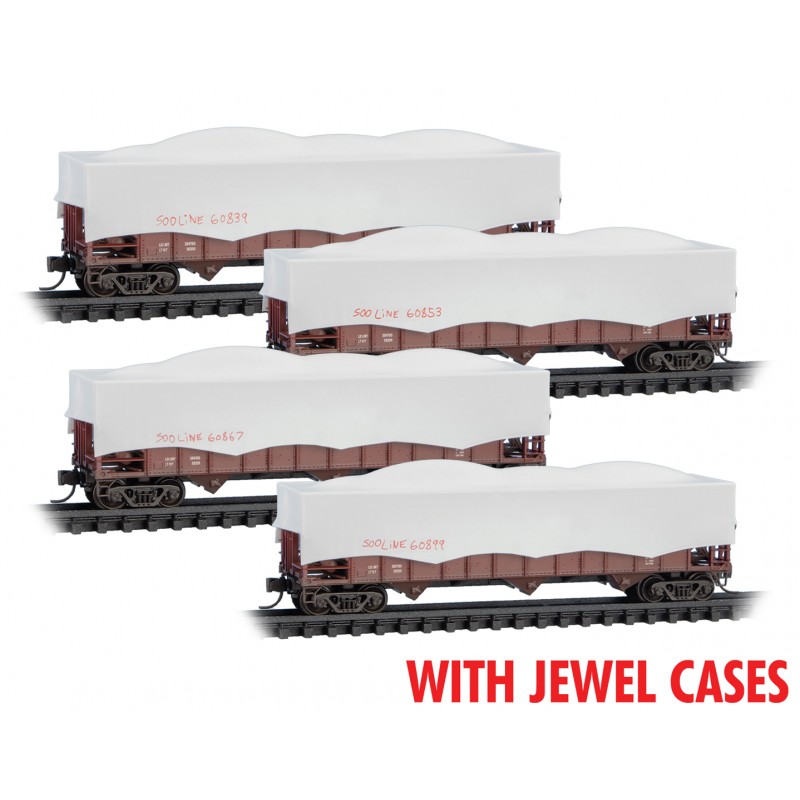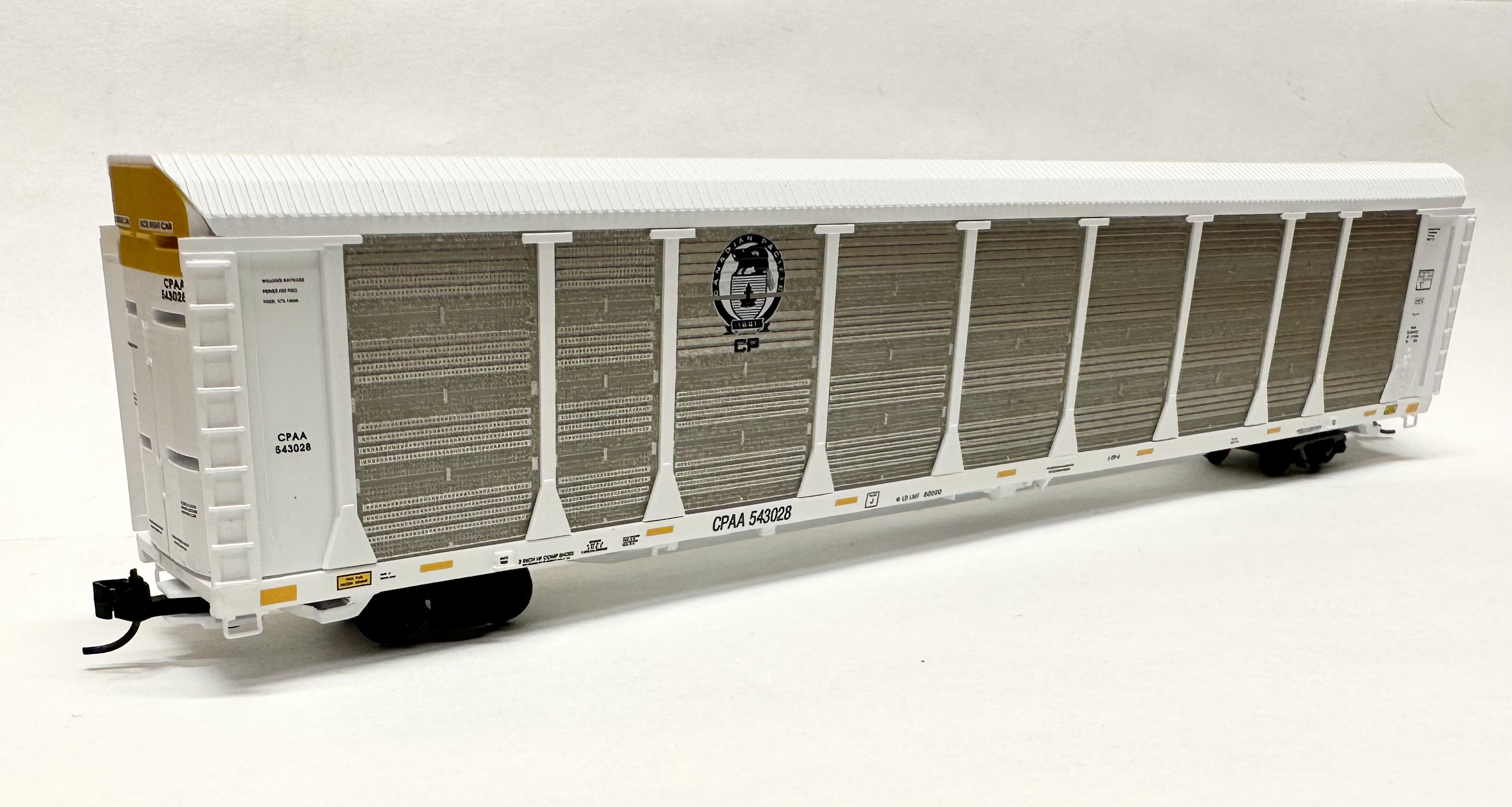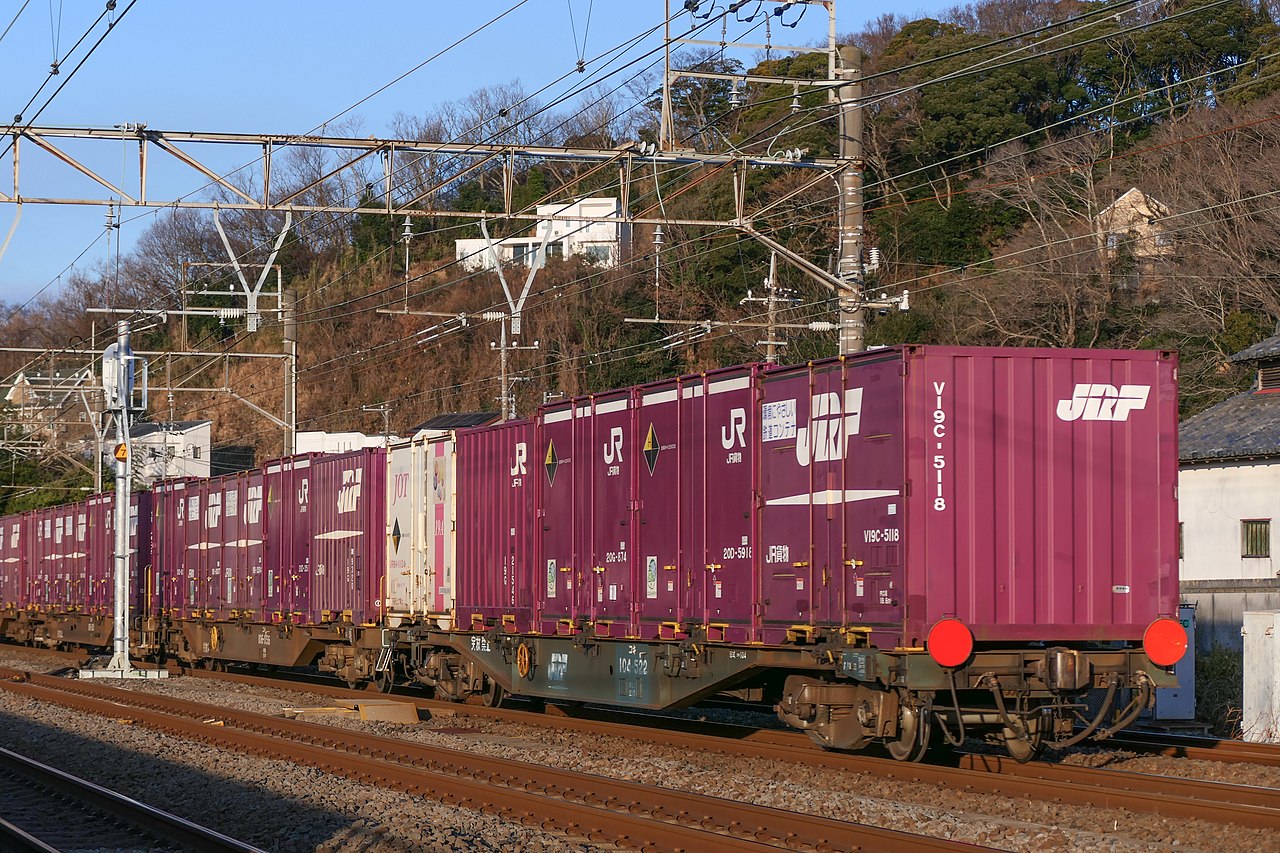Specific Item Information:
104-2406
104-2426
104-2406
104-2426
Prototype History: After the creation of JR Freight a new generation of container flat cars was developed, the 100 series (KOKI 100 to 107 and 110). Several prototypes (model 100) were produced and tested in 1987, and mass production began in 1988 with the 101 series. Among other things the new design had a 10cm lower deck than earlier models, to permit loading of ISO containers in addition to domestic containers. These supported loadings up to 40.5 tons per car (40.7 tons on the 106/107/110). Support for ISO 40-foot containers was apparently introduced on the 102 series c. 1993 or 1994, when new bearings were introduced. The Japanese wikipedia page on the 100 series has a table giving dimensions and other specifics of the differing models.
The KOKI 100 series has a top speed of 110 kph (operation may be limited to 100 kph depending on loading and the line on which it is used). Starting with the model 102 they could load up to five domestic 12-foot containers, three domestic or ISO 20-foot containers, two domestic 30-foot containers or one ISO 40-foot container. The 105 series is similar to the 104 but omits the ability to load ISO 40-foot containers, and may have been produced for use in a specific service. The 106 series was originally produced in blue, but a later production was painted gray to differentiate them, and blue ones are being repainted gray as they are brought up to the new design. The 107 is an update of the 106 design, also painted in gray, with changes to the layout of equipment (like brake cylinders). The 110 series was a specialty design for carrying 15-foot containers, and painted yellow (or “mustard”) to make this difference clear. As it can also carry standard domestic containers, these are found in general service as well.
Read more of Japanese freight cars on Sumida Crossing website.
The KOKI 100 series has a top speed of 110 kph (operation may be limited to 100 kph depending on loading and the line on which it is used). Starting with the model 102 they could load up to five domestic 12-foot containers, three domestic or ISO 20-foot containers, two domestic 30-foot containers or one ISO 40-foot container. The 105 series is similar to the 104 but omits the ability to load ISO 40-foot containers, and may have been produced for use in a specific service. The 106 series was originally produced in blue, but a later production was painted gray to differentiate them, and blue ones are being repainted gray as they are brought up to the new design. The 107 is an update of the 106 design, also painted in gray, with changes to the layout of equipment (like brake cylinders). The 110 series was a specialty design for carrying 15-foot containers, and painted yellow (or “mustard”) to make this difference clear. As it can also carry standard domestic containers, these are found in general service as well.
Read more of Japanese freight cars on Sumida Crossing website.
Road Name History: Japan Freight Railway Company (日本貨物鉄道株式会社 Nihon Kamotsu Tetsudō Kabushiki-gaisha), or JR Freight (JR貨物 Jeiāru Kamotsu), is one of the constituent companies of Japan Railways Group (JR Group). It provides transportation of cargo nationwide. Its headquarters are in Shibuya, Tokyo near Shinjuku Station.
The Japan Railways Group was founded on April 1, 1987, when Japanese National Railways (JNR) was privatized, and then divided into six regional companies and Japan Freight Railway Company. Although the passenger operation of JNR was split into six companies, fares and regulations are standard for all companies and every region of Japan except Okinawa is covered by the railway network spanning approximately 19,800 kilometres (12,300 mi).
Formerly part of JNR, the freight operation was not divided and became a single separate company when JNR was privatized and split. Although it has only about fifty kilometers of track of its own, it also operates on track owned by the JR passenger railways and other companies. The company uses the initials JRF as an abbreviated name for identification.
From Wikipedia
The Japan Railways Group was founded on April 1, 1987, when Japanese National Railways (JNR) was privatized, and then divided into six regional companies and Japan Freight Railway Company. Although the passenger operation of JNR was split into six companies, fares and regulations are standard for all companies and every region of Japan except Okinawa is covered by the railway network spanning approximately 19,800 kilometres (12,300 mi).
Formerly part of JNR, the freight operation was not divided and became a single separate company when JNR was privatized and split. Although it has only about fifty kilometers of track of its own, it also operates on track owned by the JR passenger railways and other companies. The company uses the initials JRF as an abbreviated name for identification.
From Wikipedia
Brand/Importer Information: Kato Precision Railroad Models (関水金属株式会社 Sekisui Kinzoku Kabushikigaisha) is a Japanese manufacturer of model railroad equipment in N and HO scales. The Tokyo-based company manufactures models based on Japanese prototypes (such as the Shinkansen bullet train) for the Japanese market, North American prototypes for the North American market and European high-speed trains for European market.
The Kato (pronounced kah-toe) model railroad companies were founded by Yuji Kato, father of current president Hiroshi Kato, of the parent company Sekisui Kinzoku Co., Ltd.
The design and distribution of models for the North American market are handled by their U.S. subsidiary, Kato USA, located in Schaumburg, Illinois.
The design of special models for the European market is handled for some of them by their partner, Lemke, whereas the general distribution of Kato products in Europe is handled by NOCH; both companies are located in Germany.
As a result, some Kato European models are sold as Kato Lemke and others as Kato (alone).
The Kato (pronounced kah-toe) model railroad companies were founded by Yuji Kato, father of current president Hiroshi Kato, of the parent company Sekisui Kinzoku Co., Ltd.
The design and distribution of models for the North American market are handled by their U.S. subsidiary, Kato USA, located in Schaumburg, Illinois.
The design of special models for the European market is handled for some of them by their partner, Lemke, whereas the general distribution of Kato products in Europe is handled by NOCH; both companies are located in Germany.
As a result, some Kato European models are sold as Kato Lemke and others as Kato (alone).
Item created by: CNW400 on 2021-03-31 09:27:19. Last edited by CNW400 on 2023-11-07 14:06:00
If you see errors or missing data in this entry, please feel free to log in and edit it. Anyone with a Gmail account can log in instantly.
If you see errors or missing data in this entry, please feel free to log in and edit it. Anyone with a Gmail account can log in instantly.


